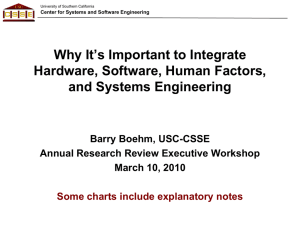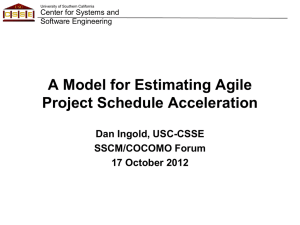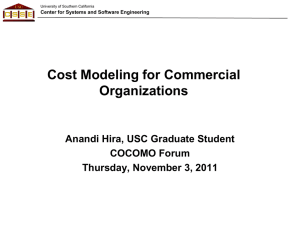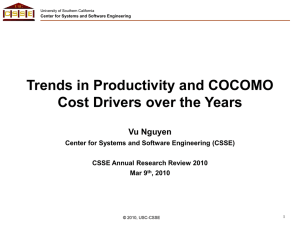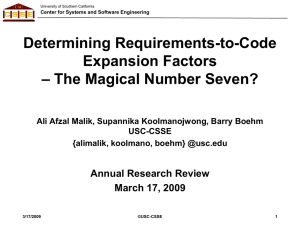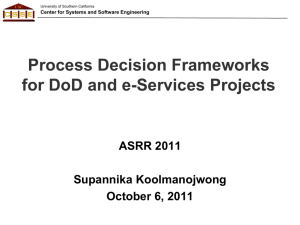Affordability-Based Engineering
advertisement
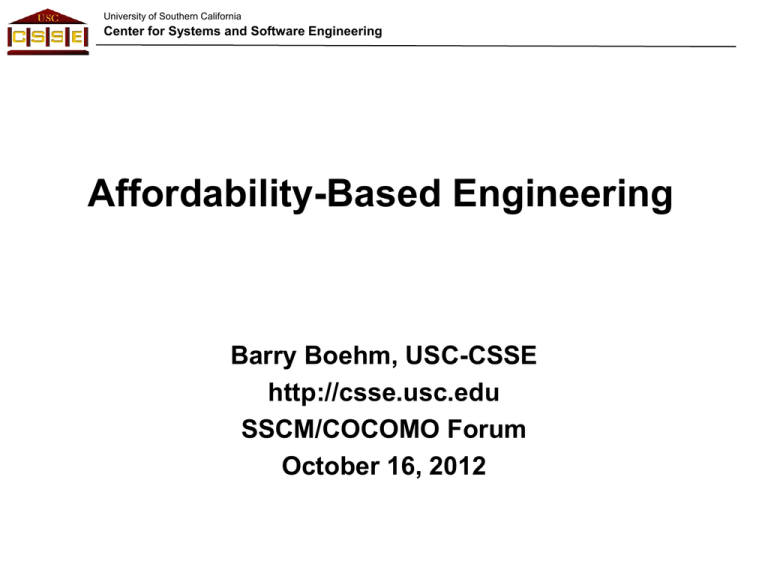
University of Southern California Center for Systems and Software Engineering Affordability-Based Engineering Barry Boehm, USC-CSSE http://csse.usc.edu SSCM/COCOMO Forum October 16, 2012 University of Southern California Center for Systems and Software Engineering Outline • Affordability definitions, concepts, issues, strategies – – – – – Addressing both costs and benefits Using life cycle present value Coping with uncertainty: incrementally; pro-actively Coping with multi-stakeholder value diversity Addressing tradeoffs with other -ilities • An orthogonal framework for improving affordability costs – Cost modeling and other insights • Conclusions October 16, 2012 Copyright © USC-CSSE 2 University of Southern California Center for Systems and Software Engineering Affordability Definitions • INCOSE: The balance of system performance, cost, and schedule constraints over the system life cycle, while satisfying mission needs in concert with strategic and organizational needs. • MORS: Cost-effective capability (USD/ATL). • NDIA: The practice of assuring program success through the balancing of system performance (KPPs), cost, and schedule constraints, while satisfying mission needs in concert with the long-range investment and force structure plans of the DoD. • Webster: Keeping within your financial means. October 16, 2012 Copyright © USC-CSSE 3 University of Southern California Center for Systems and Software Engineering Affordability Concepts Coping with uncertainty: incrementally; pro-actively Coping with multi-stakeholder value diversity Life Cycle Benefits Improvement Achievable Pareto Boundary Primary Option Space Current Situation Increasing Cost-Benefit Improvement Isoquants Life Cycle Cost Improvement October 16, 2012 Copyright © USC-CSSE 4 University of Southern California Center for Systems and Software Engineering Multi-Stakeholder Value Diversity Bank of America Master Net 5 October 16, 2012 Copyright © USC- University of Southern California Center for Systems and Software Engineering Outline • Affordability definitions, concepts, issues, strategies – – – – – Addressing both costs and benefits Using life cycle present value Coping with uncertainty: incrementally; pro-actively Coping with multi-stakeholder value diversity Addressing tradeoffs with other -ilities • An orthogonal framework for improving affordability costs – Cost modeling and other insights • Conclusions October 16, 2012 Copyright © USC-CSSE 6 University of Southern California Affordability and Tradespace Framework Center for Systems and Software Engineering Get the Best from People Make Tasks More Efficient Affordability Improvements and Tradeoffs Staffing, Incentivizing, Teambuilding Facilities, Support Services Kaizen (continuous improvement) Tools and Automation Work and Oversight Streamlining Collaboration Technology Lean and Agile Methods Eliminate Tasks Task Automation Model-Based Product Generation Eliminate Scrap, Rework Simplify Products (KISS) Early Risk and Defect Elimination Evidence-Based Decision Gates Modularity Around Sources of Change Incremental, Evolutionary Development Value-Based, Agile Process Maturity Risk-Based Prototyping Value-Based Capability Prioritization Satisficing vs. Optimizing Performance Reuse Components Domain Engineering and Architecture Composable Components,Services, COTS Legacy System Repurposing Reduce Operations, Support Costs Value- and Architecture-Based Tradeoffs and Balancing 7 Copyright October©16, USC-CSSE 2012 Automate Operations Elements Design for Maintainability, Evolvability Streamline Supply Chain Anticipate, Prepare for Change University of Southern California Center for Systems and Software Engineering Costing Insights: COCOMO II Productivity Ranges Scale Factor Ranges: 10, 100, 1000 KSLOC Development Flexibility (FLEX) Staffing Team Cohesion (TEAM) Develop for Reuse (RUSE) Teambuilding Precedentedness (PREC) Architecture and Risk Resolution (RESL) Continuous Improvement Platform Experience (PEXP) Data Base Size (DATA) Required Development Schedule (SCED) Language and Tools Experience (LTEX) Process Maturity (PMAT) Storage Constraint (STOR) Use of Software Tools (TOOL) Platform Volatility (PVOL) Applications Experience (AEXP) Multi-Site Development (SITE) Documentation Match to Life Cycle Needs (DOCU) Required Software Reliability (RELY) Personnel Continuity (PCON) Time Constraint (TIME) Programmer Capability (PCAP) Analyst Capability (ACAP) Product Complexity (CPLX) 1 1.2 1.4 1.6 1.8 Productivity Range October 16, 2012 Copyright ©8 USC-CSSE 2 2.2 2.4 University of Southern California Center for Systems and Software Engineering COSYSMO Sys Engr Cost Drivers Teambuilding Continuous Improvement Staffing October 16, 2012 Copyright © USC-CSSE 9 University of Southern California Tradespace and Affordability Framework Center for Systems and Software Engineering Get the Best from People Make Tasks More Efficient Affordability Improvements and Tradeoffs Staffing, Incentivizing, Teambuilding Facilities, Support Services Kaizen (continuous improvement) Tools and Automation Work and Oversight Streamlining Collaboration Technology Lean and Agile Methods Eliminate Tasks Task Automation Model-Based Product Generation Eliminate Scrap, Rework Simplify Products (KISS) Early Risk and Defect Elimination Evidence-Based Decision Gates Modularity Around Sources of Change Incremental, Evolutionary Development Value-Based, Agile Process Maturity Risk-Based Prototyping Value-Based Capability Prioritization Satisficing vs. Optimizing Performance Reuse Components Domain Engineering and Architecture Composable Components,Services, COTS Legacy System Repurposing Reduce Operations, Support Costs Automate Operations Elements Design for Maintainability, Evolvability Streamline Supply Chain Anticipate, Prepare for Change Value- and Architecture-Based Tradeoffs and Balancing 10 Copyright October©16, USC-CSSE 2012 University of Southern California Center for Systems and Software Engineering COCOMO II. 2000 Productivity Ranges Scale Factor Ranges: 10, 100, 1000 KSLOC Development Flexibility (FLEX) Tools Team Cohesion (TEAM) Develop for Reuse (RUSE) Collaboration Technology Precedentedness (PREC) Architecture and Risk Resolution (RESL) Work Streamlining Platform Experience (PEXP) Data Base Size (DATA) Required Development Schedule (SCED) Language and Tools Experience (LTEX) Process Maturity (PMAT) Storage Constraint (STOR) Use of Software Tools (TOOL) Platform Volatility (PVOL) Applications Experience (AEXP) Multi-Site Development (SITE) Documentation Match to Life Cycle Needs (DOCU) Required Software Reliability (RELY) Personnel Continuity (PCON) Time Constraint (TIME) Programmer Capability (PCAP) Analyst Capability (ACAP) Product Complexity (CPLX) 1 1.2 1.4 1.6 1.8 Productivity Range October 16, 2012 Copyright © 11USC-CSSE 2 2.2 2.4 University of Southern California Tradespace and Affordability Framework Center for Systems and Software Engineering Get the Best from People Make Tasks More Efficient Staffing, Incentivizing, Teambuilding Facilities, Support Services Kaizen (continuous improvement) Tools and Automation Work and Oversight Streamlining Collaboration Technology Affordability Improvements and Tradeoffs Lean and Agile Methods Eliminate Tasks Task Automation Model-Based Product Generation Eliminate Scrap, Rework Simplify Products (KISS) Early Risk and Defect Elimination Evidence-Based Decision Gates Modularity Around Sources of Change Incremental, Evolutionary Development Value-Based, Agile Process Maturity Risk-Based Prototyping Value-Based Capability Prioritization Satisficing vs. Optimizing Performance Reuse Components Domain Engineering and Architecture Composable Components,Services, COTS Legacy System Repurposing Reduce Operations, Support Costs Automate Operations Elements Design for Maintainability, Evolvability Streamline Supply Chain Anticipate, Prepare for Change Value- and Architecture-Based Tradeoffs and Balancing 12 Copyright October©16, USC-CSSE 2012 University of Southern California Center for Systems and Software Engineering Agile and Plan-Driven Home Grounds: Five Critical Decision Factors • Size, Criticality, Dynamism, Personnel, Culture Personnel (% Level 1B) (% Level 2&3) 40 15 30 20 20 25 10 30 0 Many Lives Single Essential Life Discretionary Funds Comfort Funds 35 Criticality (Loss due to impact of defects) Dynamism (% Requirements-change/month) 1.0 0.3 3.0 10 30 3 90 10 70 30 50 100 30 300 Size (# of personnel) October 16, 2012 10 Culture (% thriving on chaos vs. order) Copyright © USC-CSSE 13 University of Southern California Center for Systems and Software Engineering Architected Agile Approach • Uses Scrum of Scrums approach – Up to 10 Scrum teams of 10 people each – Has worked for distributed international teams – Going to three levels generally infeasible • General approach shown below – Often tailored to special circumstances October 16, 2012 Copyright © 14USC-CSSE University of Southern California Center for Systems and Software Engineering Trends in Software Expansion (Bernstein, 1997) MBSE:2010 1000 638 475 113 Expansion 100 Factor The ratio of machine lines of code to a source line of code 75 30 37.5 142 81 47 15 10 3 Order of Magnitude Increase Every Twenty Years 1 1960 1965 1970 1975 1980 1985 1990 1995 2000 Machine Instructions Macro Assembler High Level Language Database Manager On-line Prototyping Subsecond Time Sharing Object Oriented Programming Large Scale Reuse Regression Testing 15 October 16, 2012 4GL Small Scale Reuse Copyright © USC-CSSE University of Southern California Tradespace and Affordability Framework Center for Systems and Software Engineering Get the Best from People Make Tasks More Efficient Staffing, Incentivizing, Teambuilding Facilities, Support Services Kaizen (continuous improvement) Tools and Automation Work and Oversight Streamlining Collaboration Technology Affordability Improvements and Tradeoffs Lean and Agile Methods Eliminate Tasks Task Automation Model-Based Product Generation Eliminate Scrap, Rework Simplify Products (KISS) Early Risk and Defect Elimination Evidence-Based Decision Gates Modularity Around Sources of Change Incremental, Evolutionary Development Value-Based, Agile Process Maturity Risk-Based Prototyping Value-Based Capability Prioritization Satisficing vs. Optimizing Performance Reuse Components Domain Engineering and Architecture Composable Components,Services, COTS Legacy System Repurposing Reduce Operations, Support Costs Automate Operations Elements Design for Maintainability, Evolvability Streamline Supply Chain Anticipate, Prepare for Change Value- and Architecture-Based Tradeoffs and Balancing 16 Copyright October©16, USC-CSSE 2012 University of Southern California Center for Systems and Software Engineering COCOMO II. 2000 Productivity Ranges Scale Factor Ranges: 10, 100, 1000 KSLOC Development Flexibility (FLEX) Team Cohesion (TEAM) Develop for Reuse (RUSE) Precedentedness (PREC) Architecture and Risk Resolution (RESL) Platform Experience (PEXP) Data Base Size (DATA) Required Development Schedule (SCED) Language and Tools Experience (LTEX) Process Maturity (PMAT) Storage Constraint (STOR) Use of Software Tools (TOOL) Platform Volatility (PVOL) Applications Experience (AEXP) Multi-Site Development (SITE) Documentation Match to Life Cycle Needs (DOCU) Required Software Reliability (RELY) Personnel Continuity (PCON) Time Constraint (TIME) Programmer Capability (PCAP) Analyst Capability (ACAP) Product Complexity (CPLX) 1 1.2 1.4 1.6 1.8 Productivity Range October 16, 2012 Copyright © 17USC-CSSE 2 2.2 2.4 University of Southern California Tradespace and Affordability Framework Center for Systems and Software Engineering Get the Best from People Make Tasks More Efficient Staffing, Incentivizing, Teambuilding Facilities, Support Services Kaizen (continuous improvement) Tools and Automation Work and Oversight Streamlining Collaboration Technology Affordability Improvements and Tradeoffs Lean and Agile Methods Eliminate Tasks Task Automation Model-Based Product Generation Eliminate Scrap, Rework Simplify Products (KISS) Early Risk and Defect Elimination Evidence-Based Decision Gates Modularity Around Sources of Change Incremental, Evolutionary Development Value-Based, Agile Process Maturity Risk-Based Prototyping Value-Based Capability Prioritization Satisficing vs. Optimizing Performance Reuse Components Domain Engineering and Architecture Composable Components,Services, COTS Legacy System Repurposing Reduce Operations, Support Costs Automate Operations Elements Design for Maintainability, Evolvability Streamline Supply Chain Anticipate, Prepare for Change Value- and Architecture-Based Tradeoffs and Balancing 18 Copyright October©16, USC-CSSE 2012 University of Southern California Center for Systems and Software Engineering Value-Based Testing: Empirical Data and ROI — LiGuo Huang, ISESE 2005 100 (a) % of Value for Correct Customer Billing Bullock data – Pareto distribution 80 60 Automated test generation (ATG) tool - all tests have equal value 40 20 5 10 15 Customer Type (b) Return On Investment (ROI) 2 1.5 1 0.5 0 0 10 20 30 40 50 60 70 80 -0.5 -1 -1.5 % Tests Run Value-Neutral ATG Testing October 16, 2012 Value-Based Pareto Testing Copyright © 19USC-CSSE 90 100 University of Southern California Center for Systems and Software Engineering Sequential Requirements-First Risks It’s not a requirement if you can’t afford it $100M Required Architecture: Custom; many cache processors $50M Original Architecture: Commercial DBMS Original Budget Original Spec 1 After Prototyping 2 3 4 5 Response Time (sec) 20 October 16, 2012 Copyright © USC-CSSE University of Southern California Center for Systems and Software Engineering Value-Neutral Defect Fixing Is Even Worse Pareto 80-20 Business Value 100 Automated test generation tool - all tests have equal value 80 % of Value for Correct Customer Billing 60 40 Value-neutral defect fixing: Quickly reduce # of defects 20 5 10 15 Customer Type October 16, 2012 Copyright © USC-CSSE 21 University of Southern California Tradespace and Affordability Framework Center for Systems and Software Engineering Get the Best from People Make Tasks More Efficient Staffing, Incentivizing, Teambuilding Facilities, Support Services Kaizen (continuous improvement) Tools and Automation Work and Oversight Streamlining Collaboration Technology Affordability Improvements and Tradeoffs Lean and Agile Methods Eliminate Tasks Task Automation Model-Based Product Generation Eliminate Scrap, Rework Simplify Products (KISS) Early Risk and Defect Elimination Evidence-Based Decision Gates Modularity Around Sources of Change Incremental, Evolutionary Development Value-Based, Agile Process Maturity Risk-Based Prototyping Value-Based Capability Prioritization Satisficing vs. Optimizing Performance Reuse Components Domain Engineering and Architecture Composable Components,Services, COTS Legacy System Repurposing Reduce Operations, Support Costs Automate Operations Elements Design for Maintainability, Evolvability Streamline Supply Chain Anticipate, Prepare for Change Value- and Architecture-Based Tradeoffs and Balancing 22 Copyright October©16, USC-CSSE 2012 University of Southern California Center for Systems and Software Engineering Reuse at HP’s Queensferry Telecommunication Division 70 Time to Market 60 (months) 40 Non-reuse Project Reuse project 50 30 20 10 0 86 87 88 89 90 91 92 Year 23 October 16, 2012 Copyright © USC-CSSE University of Southern California The HMMWV Center for Systems and Software Engineering 300,000 Produced, 22 Fielded Versions Initial draft requirements in 1979, Initial delivery in 1984 Additional armor and cupola raise the CG and increase rollovers Bolt on armor required upgraded suspension, engine, and steering Mattracks or wheels Upper deck space is always at a premium Upgrades: •Increased cab space •Increased payload capacity • Strengthened frame Imbalance in cupola required motorized drive Base cab & flatbed with mission modules 9 Suspension and steering for CG shift University of Southern California Center for Systems and Software Engineering Product Line Engineering and Management October 16, 2012 Copyright © USC-CSSE 25 University of Southern California Tradespace and Affordability Framework Center for Systems and Software Engineering Get the Best from People Make Tasks More Efficient Staffing, Incentivizing, Teambuilding Facilities, Support Services Kaizen (continuous improvement) Tools and Automation Work and Oversight Streamlining Collaboration Technology Affordability Improvements and Tradeoffs Lean and Agile Methods Eliminate Tasks Task Automation Model-Based Product Generation Eliminate Scrap, Rework Simplify Products (KISS) Early Risk and Defect Elimination Evidence-Based Decision Gates Modularity Around Sources of Change Incremental, Evolutionary Development Value-Based, Agile Process Maturity Risk-Based Prototyping Value-Based Capability Prioritization Satisficing vs. Optimizing Performance Reuse Components Reduce Operations, Support Costs Value- and Architecture-Based Tradeoffs and Balancing 26 Copyright October©16, USC-CSSE 2012 Domain Engineering and Architecture Composable Components,Services, COTS Legacy System Repurposing Automate Operations Elements Design for Maintainability, Evolvability Streamline Supply Chain Anticipate, Prepare for Change University of Southern California Center for Systems and Software Engineering Post-Acquisition Costs Dominate (%O&M) • Hardware [Redman 2008] – – – – 12% -- Missiles (average) 60% -- Ships (average) 78% -- Aircraft (F-16) 84% -- Ground vehicles (Bradley) • Software [Koskinen 2010] – 75-90% -- Business, Command-Control – 50-80% -- Complex platforms as above – 10-30% -- Simple embedded software • Apply lack-of-flexibility factor to O&M component October 16, 2012 Copyright © USC-CSSE 27 University of Southern California Center for Systems and Software Engineering Overfocus on Acquisition Cost C4ISR Contracts: Nominal-case requirements; 90 days to PDR 28 October 16, 2012 Copyright © USC-CSSE University of Southern California Center for Systems and Software Engineering C4ISR Project C: Architecting for Change USAF/ESC-TRW CCPDS-R Project* When investments made in architecture, average time for change order becomes relatively stable over time… * Walker Royce, Software Project Management: A Unified Framework. Addison-Wesley, 1998. 29 October 16, 2012 Copyright © USC-CSSE University of Southern California Center for Systems and Software Engineering Relative* Total Ownership Cost (TOC) 250.00% ~5% architecture investment 200.00% ~5% architecture investment 150.00% ~25% architecture investment 100.00% 50.00% 0.00% Cycle 1 Cycle 2 Project A Cycle 3 Project B Cycle 4 Cycle 5 Project C * Cumulative architecting and rework effort relative to initial development effort 30 October 16, 2012 Copyright © USC-CSSE University of Southern California Tradespace and Affordability Framework Center for Systems and Software Engineering Get the Best from People Make Tasks More Efficient Staffing, Incentivizing, Teambuilding Facilities, Support Services Kaizen (continuous improvement) Tools and Automation Work and Oversight Streamlining Collaboration Technology Affordability Improvements and Tradeoffs Lean and Agile Methods Eliminate Tasks Task Automation Model-Based Product Generation Eliminate Scrap, Rework Simplify Products (KISS) Early Risk and Defect Elimination Evidence-Based Decision Gates Modularity Around Sources of Change Incremental, Evolutionary Development Value-Based, Agile Process Maturity Risk-Based Prototyping Value-Based Capability Prioritization Satisficing vs. Optimizing Performance Reuse Components Domain Engineering and Architecture Composable Components,Services, COTS Legacy System Repurposing Reduce Operations, Support Costs Automate Operations Elements Design for Maintainability, Evolvability Streamline Supply Chain Anticipate, Prepare for Change Value- and Architecture-Based Tradeoffs and Balancing 31 Copyright October©16, USC-CSSE 2012 University of Southern California Center for Systems and Software Engineering Tradeoffs Among Cost, Schedule, and Reliability, and Functionality: COCOMO II 9 (RELY, MTBF (hours)) 8 (VL, 1) Cost ($M) 7 (L, 10) 6 5 (N, 300) 4 (H, 10K) 3 (VH, 300K) •For 100-KSLOC set of features •Can “pick all three” with 77-KSLOC set of features 2 1 -- Cost/Schedule/RELY: “pick any two” points 0 0 10 20 30 40 50 Development Time (Months) 32 October 16, 2012 Copyright © USC-CSSE University of Southern California Center for Systems and Software Engineering A Value-Priority Tradeoff Equalizer October 16, 2012 Copyright © USC-CSSE 33 University of Southern California Center for Systems and Software Engineering Ilities in Tradespace Exploration: MIT Changeability Enabling Construct: Tradespace Networks More changeable (ie including flexible, adaptable, scalable and modifiable) Colored by outdegree For this plot, Ĉ=C∞ Survivability Enabling Construct: Epochs and Eras Value Robustness Set of Metrics © 2012 Massachusetts Institute of Technology seari.mit.edu 34 University of Southern California Center for Systems and Software Engineering Architecture-Based Attribute Trades: Flexibility Arch. Synergies Conflicts Flexibility Example (RT-18a) Strategy High module cohesion; Low module coupling Interoperability Reliability High Performance via Tight coupling Service-oriented architecture Composability, Usability, Testability High Performance via Tight coupling Autonomous adaptive systems Affordability via task automation; Response time Excess autonomy reduces human Controllability Modularization around sources of change Interoperability, Usability, Reliability, Availability Extra time on critical path of Rapid Fielding Multi-layered architecture Reliability, Availability Lower Performance due to layer traversal overhead Many built-in options, entry points Functionality, Accessibility Reduced Usability via options proliferation; harder to Secure User programmability Usability, Mission Effectiveness Full programmability causes Reliability, Safety, Security risks Spare/expandable capacity Performance, Reliability Added cost Product line architecture, reusable components Cost, Schedule, Reliability Some loss of performance vs. optimized stovepipes October 16, 2012 Copyright © USC-CSSE 35 University of Southern California Center for Systems and Software Engineering Value/Risk-Based Tradespace Analysis - Early Startup: Risk due to low dependability - Commercial: Risk due to low dependability - High Finance: Risk due to low dependability - Risk due to market share erosion Combined Risk Exposure 1 Market Share Erosion 0.8 Early Startup 0.6 RE = P(L) * S(L) Sweet Spot 0.4 Commercial High Finance 0.2 0 VL L N H VH RELY COCOMO II: 0 12 22 34 54 Added % test time COQUALMO: 1.0 .475 .24 .125 0.06 P(L) Early Startup: .33 .19 .11 .06 .03 S(L) Commercial: 1.0 .56 .32 .18 .10 S(L) High Finance: 3.0 1.68 .96 .54 .30 S(L) Market Risk: .008 .027 .30 1.0 36 .09 07/08/09 REm ©USC-CSSE University of Southern California Center for Systems and Software Engineering Conclusions • Affordability increasingly competition-critical – Need to balance cost, schedule, performance, functionality • Orthogonal framework helps tailor improvements – – – – – – – – Getting the best from people Making tasks more efficient Eliminating tasks Eliminating scrap and rework Simplifying products Reusing assets Reducing operations and support costs Value- and architecture-based tradeoffs and balancing • No one-size-fits-all solution October 16, 2012 Copyright © USC-CSSE 37 University of Southern California Center for Systems and Software Engineering Backup Charts October 16, 2012 Copyright © USC-CSSE 38 University of Southern California Center for Systems and Software Engineering Magnitude of Overrun Problem: DoD October 16, 2012 Copyright © USC-CSSE 39 University of Southern California Center for Systems and Software Engineering Magnitude of Overrun Problem: Standish Surveys of Commercial Projects Year 2000 2002 2004 2006 2008 Within budget and schedule 28 34 29 35 32 Prematurely cancelled 23 15 18 19 24 Budget or schedule overrun 49 51 53 46 44 October 16, 2012 Copyright © USC-CSSE 40 University of Southern California Center for Systems and Software Engineering Some Frequent Overrun Causes • Conspiracy of Optimism • Effects of First Budget Shortfall – System Engineering • Decoupling of Technical and Cost Analysis – Overfocus on Performance, Security, Functionality • Overfocus on Acquisition Cost • Assumption of Stability • Total vs. Incremental Commitment October 16, 2012 Copyright © USC-CSSE 41 University of Southern California Center for Systems and Software Engineering The Conspiracy of Optimism and The Cone of Uncertainty October 16, 2012 Copyright © USC-CSSE 42 University of Southern California Center for Systems and Software Engineering Effects of First Budget Shortfall: Added Cost of Weak System Engineering Calibration of COCOMO II Architecture and Risk Resolution (RESL) factor to 161 project data points October 16, 2012 Copyright © USC-CSSE 43 University of Southern California Center for Systems and Software Engineering Assumption of Stability vs. Rapid Change – Need evolutionary/incremental vs. one-shot development 4x Uncertainties in competition, technology, organizations, mission priorities 2x 1.5x 1.25x Relative Cost Range x 0.8x 0.67x 0.5x 0.25x Concept of Operation Feasibility Plans and Rqts. Detail Design Spec. Product Design Spec. Rqts. Spec. Product Design Detail Design Accepted Software Devel. and Test Phases and Milestones October 16, 2012 Copyright © USC-CSSE 44
